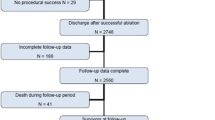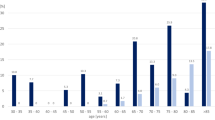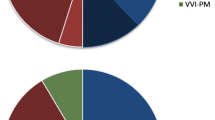Abstract
Introduction: Clinical and electrophysiological characteristics of patients with atrioventricular nodal reentrant tachycardia (AVNRT) and paroxysmal atrial fibrillation (AF) have not been studied in a large patient cohort. We aimed to define the clinical features and cardiac electrophysiological characteristics of these patients, and to examine the incidence and identify predictors of AF recurrences after elimination of AVNRT.
Methods and Results: Thirty-six patients with AVNRT and documented paroxysmal AF (Group 1) and 497 patients with AVNRT alone undergoing ablation in the same period (Group 2) were studied. There were no significant differences between groups regarding clinical features, except age, which was higher in Group 1 (p < 0.001). Presence of atrial vulnerability (induction of AF lasting > 30 seconds) and multiple AH jumps (≥50 ms) before ablation were significantly more prevalent in Group 1 (p < 0.001, p = 0.010 respectively). During follow-up of 34 ± 11 months, AF recurred in 10 patients (28%) in Group 1, while 2 patients in Group 2 (0.4%) developed paroxysmal AF (p < 0.001). Univariate predictors of AF were: left atrial diameter > 40 mm (p = 0.001), presence of mitral or aortic calcification (p = 0.003), atrial vulnerability after ablation (p = 0.015) and valvular disease (p = 0.042). However, independent predictors of AF recurrences were left atrial diameter > 40 mm (p = 0.002) and the presence of atrial vulnerability after ablation (p = 0.034).
Conclusion: In patients with both AVNRT and paroxysmal AF, the recurrence rate of AF after elimination of AVNRT is 28%. Left atrial diameter greater than 40 mm and atrial vulnerability after elimination of AVNRT are independent predictors of AF recurrences in the long term.
Similar content being viewed by others
References
Elvas L, Gursoy S, Brugada J, Andries E, Brugada P. Atrioventricular nodal reentrant tachycardia:A review. Can J Cardiol 1994;10:342–348.
Wolf PA, Abbott RD, Kannel WB. Atrial fibrillation as an independent risk factor for stroke:The Framingham Study. Stroke 1991;22:983–988.
Hurwitz JL, German LD, Packer DL, Wharton JM, McCarthy EA, Wilkinson WE, Prystowsky EN, Pritchett EL. Occurrence of atrial fibrillation in patients with paroxysmal supraventricular tachycardia due to atrioventricular nodal reentry. Pacing Clin Electrophysiol 1990;13:705–710.
Hamer ME, Wilkinson WE, Clair WK, Page RL, McCarthy EA, Pritchett EL. Incidence of symptomatic atrial fibrillation in patients with paroxysmal supraventricular tachycardia. J Amer Coll Cardiol 1995;25:984–988.
Haissaguerre M, Gaita F, Fischer B, Commenges D, Montserrat P, d'Ivernois C, Lemetayer P, Warin JF. Elimination of atrioventricular nodal reentrant tachycardia using discrete slow potentials to guide application of radiofrequency energy. Circulatio 1992;85:2162–2175.
Leitch J, Klein GJ, Yee R, Murdock C. Invasive electrophysiologic evaluation of patients with supraventricular tachycardia. Cardiol Clin 1990;8:465–477.
Kose S, Amasyali B, Aytemir K, Kilic A, Can I, Kursaklioglu H, Celik T, Isik E. Atrioventricular nodal reentrant tachycardia with multiple discontinuities in the atrioventricular node conduction curve:Immediate success rates of radiofrequency ablation and long-term clinical follow-up results as compared to patients with single or no AH-jumps. J Interv Card Electrophysiol 2004;10:249–254.
D'Este D, Pasqual A, Bertaglia M, Meneghello MP, Zanocco A, Delise P, D'Este F, Pascotto P. Evaluation of atrial vulnerability with transesophageal stimulation in patients with atrioventricular junctional reentrant tachycardia. Comparison with patients with ventricular pre-excitation and with normal subjects. Eur Heart J 1995;16:1632–1636.
Calkins H, el-Atassi R, Kalbfleisch S, Langberg J, Morady F. Effects of an acute increase in atrial pressure on atrial refractoriness in humans. Pacing Clin Electrophysiol 1992;15:1674–1680.
Calkins H, Maughan WL, Kass DA, Sagawa K, Levine JH. Electrophysiological effect of volume load in isolated canine hearts. Amer J Physiol 1989;256:H1697–H1706.
Zipes DP, Mihalick MJ, Robbins GT. Effects of selective vagal and stellate ganglion stimulation of atrial refractoriness. Cardiovasc Res 1974;8:647–655.
Buxton AE, Waxman HL, Marchlinski FE, Josephson ME. Atrial conduction:Effects of extrastimuli with and without atrial dysrhythmias. Amer J Cardiol 1984;54:755–761.
Cosio FG, Palacios J, Vidal JM, Cocina EG, Gomez-Sanchez MA, Tanargo L. Electrophysiologic studies in atrial fibrillation:Slow conduction of premature impulses:A possible manifestation of the background for reentry. Amer J Cardiol 1983;51:122–130.
Papageorgiou P, Monahan K, Boyle NG, Seifert MJ, Beswick P, Zebede J, Epstein LM, Josephson ME. Site-dependent intra-atrial conduction delay. Relationship to initiation of atrial fibrillation. Circulation 1996;94:384–389.
Chen YJ, Tai CT, Hsieh MH, Tsai CF, Lin WS, Chen SA. Dependence of electrogram duration in right posteroseptal atrium and atrium-pulmonary vein junction on pacing site:Mechanism and implications regarding atrioventricular nodal reentrant tachycardia and paroxysmal atrial fibrillation. J Cardiovasc Electrophysiol 2000;11:506–515.
Delise P, Gianfranchi L, Paparella N, Brignole M, Menozzi C, Themistoclakis S, Mantovan R, Bonso A, Coro L, Vaglio A, Ragazzo M, Alboni P, Raviele A. Clinical usefulness of slow pathway ablation in patients with both paroxysmal atrioventricular nodal reentrant tachycardia and atrial fibrillation. Amer J Cardiol 1997;79:1421–1423.
Brugada J, Mont L, Matas M, Navarro-Lopez F. Atrial fibrillation induced by atrioventricular nodal reentrant tachycardia. Amer J Cardiol 1997;79:681–682.
Weiss R, Knight BP, Bahu M, Zivin A, Souza J, Goyal R, Daoud E, Man KC, Strickberger SA, Morady F. Long-term follow-up after radiofrequency ablation of paroxysmal supraventricular tachycardia in patients with tachycardia-induced atrial fibrillation. Amer J Cardiol 1997;80:1609–1610.
Anselme F, Frederiks J, Papageorgiou P, Monahan KM, Epstein LM, Spach MS, Josephson ME. Nonuniform anisotropy is responsible for age-related slowing of atrioventricular nodal reentrant tachycardia. J Cardiovasc Electrophysio 1996;7:1145–1153.
Author information
Authors and Affiliations
Corresponding author
Rights and permissions
About this article
Cite this article
Amasyali, B., Kose, S., Aytemir, K. et al. Atrioventricular Nodal Reentrant Tachycardia with Paroxysmal Atrial Fibrillation: Clinical and Electrophysiological Features and Predictors of Atrial Fibrillation Recurrence Following Elimination of Atrioventricular Nodal Reentrant Tachycardia. J Interv Card Electrophysiol 13, 195–201 (2005). https://doi.org/10.1007/s10840-005-2225-6
Received:
Accepted:
Issue Date:
DOI: https://doi.org/10.1007/s10840-005-2225-6




